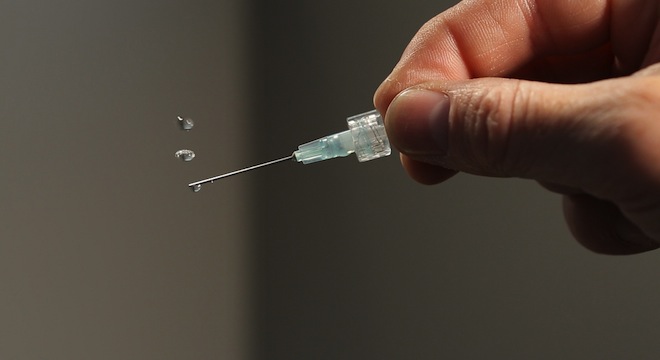Scientists at Argonne National Laboratory outside of Chicago, Illinois, have developed a specialized “acoustic levitator,” a device capable of defying gravity by levitating light objects and droplets of liquid in mid-air, which the scientists are using to research more effective pharmaceutical drugs.
The device consists of specialized audio speakers, one placed directly over the other with a large gap separating them. The speakers emit sound waves with frequencies just outside of the high-end of the range audible to humans, 22 kilohertz. The sound waves generated by each speaker interfere with each another, creating a standing wave, which allows for light objects to be levitated when placed into the gap.
As Argonne explained in a news release:
At certain points along a standing wave, known as nodes, there is no net transfer of energy at all. Because the acoustic pressure from the sound waves is sufficient to cancel the effect of gravity, light objects are able to levitate when placed at the nodes.
Check out a video fo the otherworldly acoustic levitation effect in action here, via Argonne:
The device can levitate objects as heavy as a brass sphere, but is mainly used for organic molecules.
Argonne scientists led by X-ray physicist Chris Benmore created the device because they are trying to find a way to keep pharmaceuticals amorphous, that is, disordered on the molecular level, making them more soluble in liquids and allowing them to be more effectively absorbed by the human body than most currently available drugs, which possess orderly, crystalline molecular structures.
“The increase in solubility ranges from drug to drug but it’s quite common to find ten times more of the drug in the bloodstream,” Benmore told TPM via email, of the difference between amorphous and crystalline form drugs. “Most drugs on the market are crystalline, only a few are non-crystalline.”
Specifically, amorphous pharmaceuticals currently available include Crestor, Accupril, Rezulin, Accolate and Kaletra, according to Benmore.
If Benmore and his colleagues can keep other types of drugs amorphous, the process will require less amount of the drug to begin with as more is actually being absorbed into the bloodstream, resulting in higher efficiency.
But in order to keep the drugs amorphous, Benmore and his colleagues had to turn to the innovative acoustic levitation technique.
That’s because amorphous drugs don’t want to stay amorphous. They can quickly turn back into crystalline drugs if some of the solution they’re mixed in evaporates while in contact with the interior of the vessels in which they’re stored.
Yet the drugs need to be evaporated without touching anything in order to be converted from crystalline to amorphous form, creating a conundrum.
“The main problem with amorphous drugs is shelf life — they will tend to crystallize over time,” Benmore wrote to TPM. “Hopefully our technique will prolong the shelf life as we will freeze in a structure far away from the crystalline form. Any hint of even tiny crystals in the amorphous form can lead to the structure reverting back to a crystal.”
Specifically, Benmore and his colleagues have used the acoustic levitator to levitate and evaporate, or “amorphize,” small beads of liquid and gel pharmaceutical solution while scanning them using Argonne’s Advanced Photon Source high-energy X-ray beam, the brightest x-rays generated by such a machine in the Western Hemisphere, in order to determine the best techniques for processing the drugs.
Companies including Abbott labs and Improved Pharma have been in contact with Argonne about the technique.
As for how Argonne scientists get the drugs out of the way of the levitator once they’ve been amorphized — that’s a delicate process as well.
“For the laser heated samples we scoop the solid out with a wire mesh spoon, so as not to disrupt the sound waves,” Benmore explained to TPM “For the gels we inserted a small dish of nitrogen under the sample so it would solidify on falling.”
Benmore said that he and his collagues had used the acoustic levitator to amorphize HIV drugs Ritonavir and Efavirenz, which Benmore noted are “already 90% effective…by making the drugs in glassy form more of the drug is absorbed by the body and the side effects (stomach cramps) are minimized.”
Argonne scientists have also toyed with levitating other materials, too.
“We have supercooled water to -20C in the levitator and amorphized coffee,” Benmore said.
Benmore explained that the idea to use an acoustic levitator to amorphize drugs and other materials first came about in 2009, when he and his colleague, Argonne scientist Rick Weber, who specializes in specialized materials and instrumentation, “were playing around trying to re-create an X-ray measurement on crystallizing aspirin under containerless conditions.”
Acoustic levitators were originally developed by NASA to simulate the weightlessness experienced in outer space.
As for the ultimate question — what happens when you stick your hand in Argonne’s acoustic levitator? — Benmore said it wouldn’t be a good idea.
“Sticking your hand in it would disrupt the sound waves and the droplets would all fall out,” Benmore told TPM. “If there are no strong drafts we don’t need a shield, but to minimize dust (which could cause nucleation) have a plastic box to go around the levitator.”
Undesirable, but still better than the results of sticking your hand in another, unrelated highly advanced piece of research equipment.






